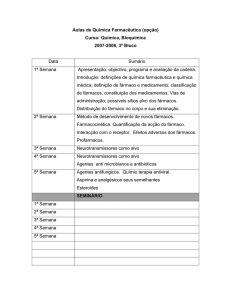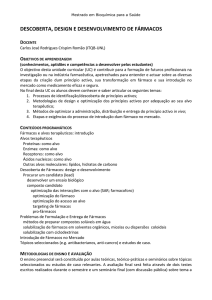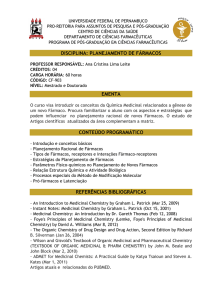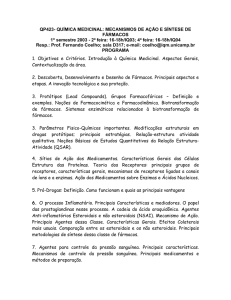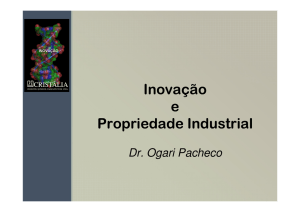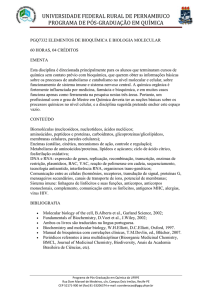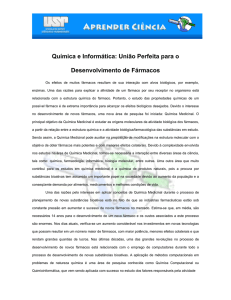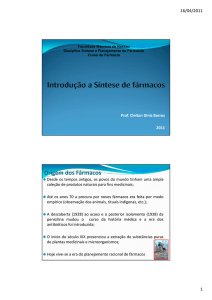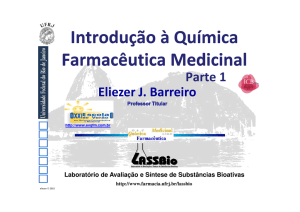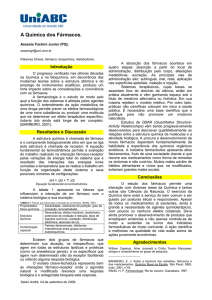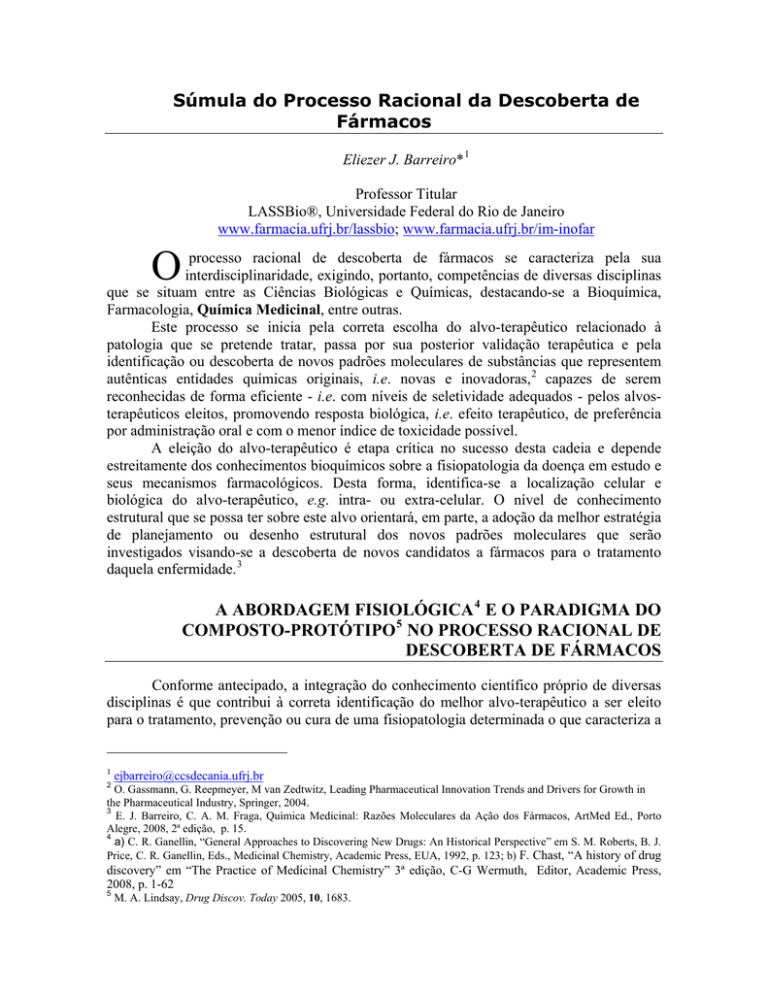
Súmula do Processo Racional da Descoberta de
Fármacos
Eliezer J. Barreiro* 1
Professor Titular
LASSBio®, Universidade Federal do Rio de Janeiro
www.farmacia.ufrj.br/lassbio; www.farmacia.ufrj.br/im-inofar
O
processo racional de descoberta de fármacos se caracteriza pela sua
interdisciplinaridade, exigindo, portanto, competências de diversas disciplinas
que se situam entre as Ciências Biológicas e Químicas, destacando-se a Bioquímica,
Farmacologia, Química Medicinal, entre outras.
Este processo se inicia pela correta escolha do alvo-terapêutico relacionado à
patologia que se pretende tratar, passa por sua posterior validação terapêutica e pela
identificação ou descoberta de novos padrões moleculares de substâncias que representem
autênticas entidades químicas originais, i.e. novas e inovadoras, 2 capazes de serem
reconhecidas de forma eficiente - i.e. com níveis de seletividade adequados - pelos alvosterapêuticos eleitos, promovendo resposta biológica, i.e. efeito terapêutico, de preferência
por administração oral e com o menor índice de toxicidade possível.
A eleição do alvo-terapêutico é etapa crítica no sucesso desta cadeia e depende
estreitamente dos conhecimentos bioquímicos sobre a fisiopatologia da doença em estudo e
seus mecanismos farmacológicos. Desta forma, identifica-se a localização celular e
biológica do alvo-terapêutico, e.g. intra- ou extra-celular. O nível de conhecimento
estrutural que se possa ter sobre este alvo orientará, em parte, a adoção da melhor estratégia
de planejamento ou desenho estrutural dos novos padrões moleculares que serão
investigados visando-se a descoberta de novos candidatos a fármacos para o tratamento
daquela enfermidade. 3
A ABORDAGEM FISIOLÓGICA 4 E O PARADIGMA DO
COMPOSTO-PROTÓTIPO 5 NO PROCESSO RACIONAL DE
DESCOBERTA DE FÁRMACOS
Conforme antecipado, a integração do conhecimento científico próprio de diversas
disciplinas é que contribui à correta identificação do melhor alvo-terapêutico a ser eleito
para o tratamento, prevenção ou cura de uma fisiopatologia determinada o que caracteriza a
1
2
[email protected]
O. Gassmann, G. Reepmeyer, M van Zedtwitz, Leading Pharmaceutical Innovation Trends and Drivers for Growth in
the Pharmaceutical Industry, Springer, 2004.
3
E. J. Barreiro, C. A. M. Fraga, Química Medicinal: Razões Moleculares da Ação dos Fármacos, ArtMed Ed., Porto
Alegre, 2008, 2ª edição, p. 15.
4
a) C. R. Ganellin, “General Approaches to Discovering New Drugs: An Historical Perspective” em S. M. Roberts, B. J.
Price, C. R. Ganellin, Eds., Medicinal Chemistry, Academic Press, EUA, 1992, p. 123; b) F. Chast, “A history of drug
discovery” em “The Practice of Medicinal Chemistry” 3ª edição, C-G Wermuth, Editor, Academic Press,
2008, p. 1-62
5
M. A. Lindsay, Drug Discov. Today 2005, 10, 1683.
Instituto Nacional de Ciência e Tecnologia Inovação e Desenvolvimento de Fármacos e Medicamentos – INCT-INOFAR
2
abordagem fisiológica,25 que objetiva a identificação de novos compostos-protótipos.26 Esta
etapa da cadeia de inovação em fármacos é crítica ao sucesso neste complexo processo de
descoberta de novos fármacos 6 .
O planejamento e o desenho estrutural de novos padrões moleculares de substâncias
que possuam propriedades farmacoterapêuticas úteis, capazes de representarem novos
compostos-protótipos de fármacos, é uma tarefa complexa pela multiplicidade de fatores
que influenciam resposta terapêutica de uma substância exógena, e.g. fármaco, que precisa
apresentar elevada eficácia, reflexo das propriedades farmacodinâmicas - aquelas que
regem as interações responsáveis pelo reconhecimento molecular do fármaco pelo
biorreceptor e resultam na resposta terapêutica desejada - e farmacocinéticas - aquelas que
governam os fatores de absorção, distribuição, metabolismo e eliminação do fármaco na
biofase, resultando no perfil de biodisponibilidade.
A abordagem fisiológica, baseada no mecanismo de ação farmacológico pretendido
para o novo fármaco, se fundamenta no prévio conhecimento do processo fisiopatológico e
na conseqüente eleição do alvo-terapêutico mais adequado e busca o planejamento de
novos padrões estruturais, originais, ativos in vivo, candidatos a compostos-protótipos de
fármacos. 7
A heurística deste processo determina, portanto, que quando da eleição prévia do
alvo-terapêutico se identifique sua localização celular, e.g. membrânico, transmembrânico
ou intracelular, bem como o tipo de intervenção terapêutica que se pretenda realizar e.g.
inibição enzimática, antagonista ou agonista de biorreceptores 8 . A escolha da estratégia de
planejamento estrutural a ser adotada para o desenho molecular do novo ligante, dependerá
do nível de conhecimento da estrutura do alvo terapêutico eleito.
Figura 1 - A abordagem fisiológica no contexto da descoberta de fármacos segundo
a química medicinal clássica
6
R. E. Hubbard (Editor), Structure-Based Drug Discovery, RSC Publishing, Cambridge, 2006.
J. G. Lombardino, J. A. Lowe, III, Nature Rev. Drug Disc. 2004, 3, 853..
8
P. Imming, C. Sinning, A. Meyer, Nat. Rev. Drug Disc. 2006, 5, 821..
7
Instituto Nacional de Ciência e Tecnologia Inovação e Desenvolvimento de Fármacos e Medicamentos – INCT-INOFAR
3
Caso seja conhecida a estrutura tridimensional (3D) do alvo-eleito e,
principalmente, aquela do sítio de reconhecimento molecular, o planejamento molecular de
ligante seletivo pode apelar para estratégias baseadas na química computacional. 9
Identificado o novo padrão estrutural este será sintetizado e avaliado através de bioensaios
in vitro que em caso de sucesso nos fornece.um novo ligante do biorreceptor eleito como
alvo-terapêutico. 10 Uma vez disponível sinteticamente em estado de pureza adequado, o
novo ligante é submetido à etapa de validação do conceito terapêutico à origem da eleição
do alvo, compreendendo o emprego de bioensaios farmacológicos, in vivo. Esta etapa é
crítica no processo pois além de validar experimentalmente o conceito terapêutico do alvo
eleito permite identificar-se as propriedades farmacocinéticas (FK) do ligante candidato a
novo composto-protótipo. Em caso de sucesso nesta etapa, temos a descoberta de novo
composto-protótipo, candidato a fármaco atuando no receptor eleito o que representa
importante resultado na cadeia de inovação em fármacos (Figura 1).
Alternativamente, quando a estrutura do alvo terapêutico não é conhecida 11 , o
desenho molecular de novos padrões estruturais do candidato a composto-protótipo
desejado, pode ser conduzido a partir do emprego de estratégias de planejamento estrutural
da Química Medicinal 12 e.g. identificação de novos análogos ativos do substrato natural do
receptor ou do agonista da enzima eventualmente eleita como alvo-terapêutico. O
planejamento molecular racional destes análogos-ativos pode se dar pelo emprego do
bioisosterismo, 13 da simplificação molecular,14 da hibridação molecular 15 , entre outras
metodologias de planejamento molecular da Química Medicinal. 16 Uma vez definidos e
sintetizados, os novos compostos são ensaiados farmacologicamente, empregando-se
protocolos in vivo, o que permite a identificação de novos compostos-protótipos de novos
fármacos.
Cabe ressaltar, que independente da estratégia adotada para o planejamento
molecular dos novos padrões estruturais dos candidatos a compostos-protótipos, deve-se,
obrigatoriamente, levar em conta todas as possíveis contribuições toxicofóricas das subunidades estruturais presentes estrutura química da série congênere de compostos
9
A pesquisa de novos candidatos a protótipos nos laboratórios de empresas farmacêuticas que descobrem fármacos ou em
spin-offs, sob contrato, pode empregar técnicas de avaliação de quimiotecas de compostos naturais ou sintéticos, obtidos
combinatoriamente, ou não, acoplados aos bioensaios robotizados que propiciam a análise de milhares de amostras de
substâncias puras ou em misturas combinatórias. A identificação de novos compostos ativos por estas técnicas, geralmente
na escala nM, representa a descoberta de um hit, que por ser um mero ligante tem que ser validado em ensaios com
animais.
10
Para um recente artigo discutindo as conceituações e distinções entre hit, ligante e composto-protótipo, veja: b) T. I.
Oprea, A. M. Davis, S. J. Teague, P. D. Leeson, J. Chem. Inf. Comp. Sci. 2001, 41, 1308.
11
C. R. Ganellin em Chronicles of Drug Discovery, D Lednicer, Ed., Wiley, 1990,
12
E. J. Barreiro, C. A. M. Fraga, Química Medicinal: Razões Moleculares da Ação dos Fármacos, ArtMed Ed., Porto
Alegre, 2ª edição, 2008.
13
a) E.J. Barreiro Current Medicinal Chemistry 2005, 12, 23 b) G.A. Patani & E.J. LaVoie, Chem. Rev 1996, 96, 3147.
14 Para
exemplo da utilização desta estratégia no desenho de novos candidatos a protótipos de fármacos no LASSBio, veja:
E. J. Barreiro, Quim. Nova 2002, 25, 1172.
15 Para
exemplo da utilização desta estratégia no desenho de novos candidatos a protótipos de fármacos no LASSBio, veja:
A. G. M. Fraga, A. L. P. Miranda, C. A. M. Fraga, E. J. Barreiro, Eur. J. Pharm. Sc. 2000, 11, 285; Para exemplo da
utilização desta estratégia no desenho de novos candidatos a protótipos de fármacos no LASSBio-UFRJ, veja: E. J.
Barreiro,Química Nova 2002, 25, 1172.
16
D. Flower (Editor), Drug Design: Cutting Edge Approaches (Special Publication), Royal Society of Chemistry, 256 p.,
Londres, 2002; b) A. Burger, Prog. Drug Res.,1991, 36, 287; Drug Design: Cutting Edge Approaches (Special
Publication), RSC, 256 p., 2002
Instituto Nacional de Ciência e Tecnologia Inovação e Desenvolvimento de Fármacos e Medicamentos – INCT-INOFAR
4
planejados, especialmente quanto ao potencial tóxico relacionado ao sistema microssomal
do retículo endotelial hepático, responsável por oxidações dependentes do CYP450,
essenciais à bioformação de substâncias endógenas, essenciais ao correto funcionamento de
funções fisiológicas vitais e.g. hormônios esteróidais . 17 A presença de grupos funcionais
eletrofílicos (e.g. grupos funcionais aceptores de Michael, epóxidos, i.e. intermediáriosreativos) e sub-unidades estruturais extensamente coplanares, devem ser consideradas
como atributo de potencial hepato- e citotoxicidade, respectivamente, devendo ser,
portanto, evitadas. Ademais, assim procedendo reduz-se o risco de identificarem-se,
posteriormente, propriedades tóxicas indesejáveis que condenem o composto-protótipo
descoberto.
A ETAPA DE OTIMIZAÇÃO DO COMPOSTO-PROTÓTIPO 18
Uma vez descoberto o novo composto-protótipo, a etapa seguinte na cadeia de
inovação em fármacos é sua otimização. Para tanto, nesta etapa, devem ser identificadas as
distintas contribuições farmacofóricas de todas suas sub-unidades estruturais, de maneira a
orientar as modificações moleculares a serem introduzidas na estrutura do compostoprotótipo ampliando a diversidade estrutural deste padrão molecular, o que é
significativamente relevante para a elaboração de pedidos de proteção intelectual desta
descoberta.
Na etapa de otimização do composto-protótipo, o emprego de técnicas de química
computacional aplicadas aos desenho de fármacos são particularmente úteis, e.g. QSAR,
CoMFA, CoNSIA, 19 entre outras. 20, 21 Ademais, a construção de modelos topográficos 3D
do sítio de reconhecimento molecular do biorreceptor 22 orienta, ao menos teoricamente, as
modificações moleculares necessárias à otimização das propriedades farmacodinâmias (FD)
do protótipo.
A etapa de otimização do composto-protótipo deve ser realizada simultaneamente
àquela da investigação das propriedades de biodisponibilidade do protótipo-eleito, 23 de
maneira a instruir sobre a necessidade de se introduzirem novas modificações moleculares
na sua estrutura, visando otimizar, também, suas propriedades farmacocinéticas (FK).
Ademais, este procedimento antecipa, por sua vez, preciosas informações para a futura
etapa de desenvolvimento galênico do composto-protótipo descoberto.
A realização dos ensaios de toxidez sub-aguda, compreendendo a determinação da
dose letal média e sua relação com a dose efetiva média, i.e. LD50 e ED50, respectivamente,
devem ser realizados, simultaneamente nesta etapa, de maneira a se estabelecer o provável
índice terapêutico do novo candidato a fármaco. Ensaios subseqüentes de toxidez aguda,
determinando-se histologicamente eventuais efeitos sobre a morfologia dos principais
17
E. J. Barreiro, C. A. M. Fraga, Química Medicinal: Razões Moleculares da Ação dos Fármacos, ArtMed Ed., Porto
Alegre, 2008, 2ª edição, p 35.
18
E. J. Barreiro, C. A. M. Fraga, Química Medicinal: Razões Moleculares da Ação dos Fármacos, ArtMed Ed., Porto
Alegre, 2008, 2ª edição, p. 108.
36
P. Gund, G. Maggiora, J. P. Snyder, “Guidebook on Molecular Modeling in Drug Design”, N. C. Cohen, Ed., Academic
Press, 1996, NY, p. 219.
37
H-D. Höltje, The Practice of Medicinal Chemistry, C-G. Wermuth, Ed., 2a edição, Academic Press, NY, 2003, p. 387.
38
A. Itai, Y. Mizutani, Y. Nishibata, N. Tomioka, Guidebook on Molecular Modeling in Drug Design, N. C. Cohen, Ed.,
Academic Press, 1996, NY, p. 93.
39
E. J. Barreiro, M. G. Albuquerque, C. M. R. Sant’Anna, R. B. Alencastro, Quim. Nova 1997, 29, 300.
23
Cf. B. M. Bolten, T. DeGregorio, Nature Rev, Drug Disc. 2002, 1, 335.
Instituto Nacional de Ciência e Tecnologia Inovação e Desenvolvimento de Fármacos e Medicamentos – INCT-INOFAR
5
órgãos, i.e. fígado, pulmão e sistema nervoso central, além dos efeitos sobre a concentração
plasmática dos principais agentes bioquímicos, e.g. uréia, glicose, atividade transaminase,
entre outros, devem ser realizados anteriormente aos estudos pré-clínicos, em mais de uma
espécie de animais de laboratório 24 .
Neste estágio do processo, caso o composto-protótipo descoberto tenha superado
todas as etapas relatadas, consecutivamente, temos a descoberta de nova entidade molecular
(NME’s) 25 que representa, na prática, a etapa imediatamente anterior àquela dos ensaios
pré-clínicos, essenciais para que se observe o potencial de uso seguro do candidato a novo
fármaco, propriamente dito. Em caso de sucesso na descoberta de NME se deve iniciar as
negociações com os setores empresariais farmacêuticos interessados, pois representa uma
descoberta de grande valor agregado, sendo, efetivamente, um candidato a fármaco.
SÍNTESE DO COMPOSTO-PROTÓTIPO EM ESCALA
COMPATÍVEL COM O ESTADO DE DESENVOLVIMENTO NA
CADEIA DE INOVAÇÂO
A síntese multi-etapas de uma substância orgânica exige cuidadoso planejamento
preliminar, onde os diferentes estágios, envolvendo a construção de diferentes ligações CC, C-N, C-S e C-H, entre outras, traduzam uma seqüência viável, onde, por exemplo, a
compatibilidade dos diferentes grupos funcionais presentes seja previamente considerada
objetivando transformações quimiosseletivas. 26 Em sua ampla maioria os fármacos são
substâncias orgânicas de peso molecular compreendido entre 200-500 unidades de massa
atômica, contendo de cinco a sete elementos da Tabela Periódica (e.g. C, N, H. S, O, F, Cl)
e predominantemente de natureza heterocíclica e, sempre que possível, aquirais. As
distintas estratégias disponíveis na Química Orgânica Sintética se aplicam na síntese de
fármacos, em particular a retrossíntese, que permite o planejamento de maior número de
rotas sintéticas, alternativas, para um mesmo composto, identificando, inclusive,
intermediários comuns.
Os blocos estruturais a serem empregados como matéria-prima de partida definem a
facilidade e os custos da rota sintética. Há de ser salientado que a síntese de fármacos tem
características próprias, relacionadas à acessibilidade de matérias-primas, metodologias de
elevada reprodutibilidade e de bons rendimentos químicos. Nesta etapa a expertise do
químico medicinal sintético é essencial.27 Cabe menção a regra empírica definida pelo
Professor Camille Georges Wermuth (Université Louis Pasteur, Estrasburgo, Fr.), como a
Regra da Síntese Simples 28 . É necessário destacar, ainda, que não raramente a rota sintética
24
A definição do melhor momento para realizar-se a proteção intelectual desta descoberta pode ser iniciada quando o
potencial de emprego terapêutico do novo protótipo se confirme ou quando se identifique parceria no setor empresarial
farmacêutico que assegure os custos desta etapa, ou integralmente ou em parte.
25
Um excelente glossário dos principais termos de Química Medicinal, está disponível em
http://www.chem.qmw.ac.uk/iupac/medchem/ix.html
26
D. Lednicer, L. A. Mitscher, The Organic Chemistry of Drug Synthesis, Wiley, 1977, 496 pp.
27
a) W. Cabri, R. Di Fabio, From Bench to Market: The Evolution of Chemical Synthesis, Oxford University Press, 2000;
b) Fulvio Gualtieri (Editor), New Trends in Synthetic Medicinal Chemistry (Methods & Principles in Medicinal
Chemistry), Wiley-VCH, 2000, 376p.
28
C-G. Wermuth formulou sua quinta regra empírica: the easy organic synthesis (EOS) rule. O autor cita dados
estatísticos que indicam que entre os fármacos sintéticos, maioria no arsenal terapêutico contemporâneo, 62% possui um
anel heterocíclico, no mínimo, que, em geral, são de fácil acesso sintético. (The Practice of Medicinal Chemistry, C-G.
Wermuth, Ed., 3a edição, Academic Press, 2008, p. 289-300).
Instituto Nacional de Ciência e Tecnologia Inovação e Desenvolvimento de Fármacos e Medicamentos – INCT-INOFAR
6
empregada em bancada (escala de gramas) não se presta à preparação do candidato a
fármaco em escala de quilogramas, exigindo uma interação eficaz entre o pesquisador da
síntese de bancada e este responsável pelo scale-up, preferencialmente realizado em
laboratórios localizados fora da Universidade onde se desenvolveu a etapa de bancada. 29, 30
ENGLISH VERSION
Summary of the Rational Process of Discovery of
Pharmaceuticals
Eliezer J. Barreiro* 31
Professor of Medicinal Chemistry
LASSBio®, Universidade Federal do Rio de Janeiro
www.farmacia.ufrj.br/lassbio; www.farmacia.ufrj.br/im-inofar
T
he rational process of discovery of pharmaceuticals is characterized by its
interdisplicinarity, demanding, therefore, knowledge of several subject areas
that are part of Biology and Chemistry, with an emphasis on Biochemistry, Pharmacology,
and Medicinal Chemistry, among others.
This process starts by correctly choosing the therapeutic-target related to the
pathology that one intends to treat, moves on to the later therapeutic validation and to the
identification or discovery of new molecular patterns of substances that represent authentic
original chemical entities, i.e. new and innovative, 32 capable of being recognized efficiently
- i.e. with adequate levels of selectiveness – by the therapeutic-targets chosen, promoting a
biological response, i.e. a therapeutic effect, preferably when taken orally and with the
smallest level of toxicity possible.
The choice of therapeutic-target is a critical stage in the success of this chain and
depends strictly on the biochemical knowledge of the physiopathology of the disease
studied, and its pharmacological mechanisms. As such, the cellular and biological location
of the therapeutic-target, e.g. intra- or extra-cellular, is located. The level of structural
knowledge that one can have about this target will guide, partly, the adoption of the best
29
S. Lee, G. Robinson, Process Development: Fine Chemicals from Grams to Kilograms (Oxford Chemistry Primers),
Oxford University Press, 1995, 96p
30
A. Abdel-Magid, J. A. Ragan, Chemical Process Research: The Art of Practical Organic Synthesis (ACS Symposium
S.), American Chemical Society, 2004, 323p.
31
32
[email protected]
O. Gassmann, G. Reepmeyer, M van Zedtwitz, Leading Pharmaceutical Innovation Trends and Drivers for Growth in
the Pharmaceutical Industry, Springer, 2004.
Instituto Nacional de Ciência e Tecnologia Inovação e Desenvolvimento de Fármacos e Medicamentos – INCT-INOFAR
7
strategy for planning or structural design of the new molecular patterns that will be
investigated, aiming to discover new potential pharmaceuticals for the treatment of that
disease. 33
THE PHYSIOLOGICAL APPROACH 34 AND THE PROTOTYPECOMPOUND PARADIGM 35 IN THE RATIONAL PROCESS OF
DISCOVERY OF PHARMACEUTICALS
As anticipated, the integration of scientific knowledge specific to several subject
areas is what contributes to the correct identification of the best therapeutic-target to be
chosen for treatment, prevention, or cure of a specific physiopathology, and this is what
characterizes the physiological approach,25 which aims to identify new prototypecompounds.26 This stage of the chain of innovation in pharmaceuticals is critical to the
success of this complex process of discovery of new pharmaceuticals 36 .
The planning and structural design of new molecular patterns of substances that
have useful pharmacotherapeutic properties, capable of representing new prototypecompounds of pharmaceuticals, is a complex task due to the multiple factors that influence
therapeutic response to an exogenous substance, e.g. a pharmaceutical, which needs to have
a high efficacy, a reflex of its pharmacodynamic properties – those that react to the
interactions responsible for the molecular recognition of the pharmaceutical by the
bioreceptor and that result in the therapeutic response desired – and pharmacokinetic –
those that govern the factors of absorption, distribution, metabolism, and elimination of the
pharmaceutical in the biophase, resulting in the bioavailability profile.
The physiological approach, based on the pharmacological action mechanism
intended for the new pharmaceutical, is based on previous knowledge of the
physiopathological process and in the resulting choice of the most adequate therapeutictarget, and it aims to plan new original structural patterns, active in vivo, which are
potential prototype-compounds of pharmaceuticals. 37
The heuristics of this process determines, therefore, that at the time of the previous
choice of therapeutic-target its cellular location is identified, e.g. membranic,
transmembranic or intracellular, as well as the type of therapeutic intervention that is
intended e.g. enzymatic inhibition, bioreceptor antagonist or agonist 38 . The choice of the
structural planning strategy to be adopted for the molecular design of the new ligand will
depend on the level of knowledge of the structure of the chosen therapeutic-target.
33
E. J. Barreiro, C. A. M. Fraga, Química Medicinal: Razões Moleculares da Ação dos Fármacos, ArtMed Ed., Porto
Alegre, 2008, 2ª edição, p. 15.
34
C. R. Ganellin, “General Approaches to Discovering New Drugs: An Historical Perspective” em S. M. Roberts, B. J.
Price, C. R. Ganellin, Eds., Medicinal Chemistry, Academic Press, EUA, 1992, p. 123
35
M. A. Lindsay, Drug Discov. Today 2005, 10, 1683.
36
R. E. Hubbard (Editor), Structure-Based Drug Discovery, RSC Publishing, Cambridge, 2006.
37
J. G. Lombardino, J. A. Lowe, III, Nature Rev. Drug Disc. 2004, 3, 853..
38
P. Imming, C. Sinning, A. Meyer, Nat. Rev. Drug Disc. 2006, 5, 821..
Instituto Nacional de Ciência e Tecnologia Inovação e Desenvolvimento de Fármacos e Medicamentos – INCT-INOFAR
8
Figure 1 – The physiological approach in the context of the discovery of pharmaceuticals according
to classic medicinal chemistry
If the tridimensional (3D) structure of the chosen-target is known, and most of all,
that of the molecular recognition site, the molecular planning of the selective ligand may
appeal to strategies based on Chemoinformatics. 39 Once the new structural pattern is
identified, it will be synthesized and assessed through in vitro bioassays, which if
successful will provide us with a new ligand of the bioreceptor chosen as the therapeutictarget. 40 Once available synthetically at an adequate purity state, the new ligand is
submitted to the stage of validation of the therapeutic concept to the source of the target
choice, involving the use of in vivo pharmacological bioassays. This stage is critical to the
process because aside from experimentally validating the therapeutic concept of the chosen
target, it allows us to identify the pharmacokinetic (PK) properties of the ligand that is a
potential prototype-compound. If this stage is successful, we have discovered a new
prototype-compound, a potential pharmaceutical acting on the chosen receptor, which
represents an important result in the chain of innovation in pharmaceuticals. (Figure 1).
Alternatively, when the structure of the therapeutic-target is not known 41 , the
molecular design of new structural patterns for the desired potential prototype-compound
can be done through the use of Medicinal Chemistry structural planning strategies 42 e.g.
identification of new active analogs to the natural substract of the receptor or of the enzyme
agonist finally chosen as therapeutic-target. The rational molecular planning of these
39
The research of new potential prototypes in the laboratories of pharmaceutical industries that discover pharmaceuticals
or in spin-offs, under contract, may use evaluation techniques of chemical libraries of natural or synthetic compounds,
obtained combinatorially or not, coupled with the robotic bioassays that allow for the analysis of millions of samples of
pure substances or in combinatorial mixtures. The identification of new active compounds by these techniques, in the nM
scale, represents the discovery of a hit, which by being a mere ligand has to be validated through animal assays.
40
For a recent article discussing concepts and distinctions between hit, ligand, and prototype-compound see: b) T. I.
Oprea, A. M. Davis, S. J. Teague, P. D. Leeson, J. Chem. Inf. Comp. Sci. 2001, 41, 1308.
41
C. R. Ganellin em Chronicles of Drug Discovery, D Lednicer, Ed., Wiley, 1990,
42
E. J. Barreiro, C. A. M. Fraga, Química Medicinal: Razões Moleculares da Ação dos Fármacos, ArtMed Ed., Porto
Alegre, 2ª edição, 2008.
Instituto Nacional de Ciência e Tecnologia Inovação e Desenvolvimento de Fármacos e Medicamentos – INCT-INOFAR
9
active-analogs may be done through bioisosterism, 43 molecular simplification, 44 molecular
hybridization 45 , among other molecular planning methodologies used in Medicinal
Chemistry. 46 Once defined and synthesized, the new compounds are pharmacologically
essayed, using in vivo protocols, which allows for the identification of new prototypecompounds of new pharmaceuticals.
It is worth noting that regardless of the strategy adopted for the molecular planning
of the new structural standards for the potential prototype-compounds, one should
necessarily consider all the possible toxicophoric contributions of the structural subunits
present in the chemical structure of the congeneric series of planned compounds,
particularly in regard to the toxic potential of the hepatic reticulo-endothelial microsomal
system, responsible for CYP450-dependent oxidations, essential to the correct functioning
of vital physiological e.g. steroid hormones. 47 The presence of electrophilic functional
groups (e.g. Michel acceptor functional groups, epoxides, i.e. reactive-intermediates) and
extensively coplanar structural subunits, should be considered as an attribute of potential
hepatotoxicity and cytotoxicity, respectively, and should be therefore avoided.
Furthermore, with this procedure the risk to later identify undesirable toxic properties that
condemn the discovered prototype-compound is reduced.
THE STAGE OF OPTIMIZATION OF THE PROTOTYPECOMPOUND 48
Once the new prototype-compound is discovered, the next stage in the chain of
innovation in pharmaceuticals is its optimization. To do so, in this stage it is necessary to
identify the distinct pharmacophoric contributions of all of its structural sub-units, to guide
the molecular changes to be introduced in the structure of the prototype-compound,
increasing the structural diversity of this molecular standard, which is significantly relevant
for writing a petition to guarantee the intellectual property of this discovery.
During the stage of optimization of the prototype-compound, the use of
Chemoinformatics techniques applied to the design of pharmaceuticals is particularly
useful, e.g. QSAR, CoMFA, CoNSIA, among others. Furthermore, the construction of 3D
topographical models of the molecular recognition site for the bioreceptor guides, at least
theoretically, the molecular changes necessary to the optimization of the pharmacodynamic
properties (PD) of the prototype.
43
a) E.J. Barreiro Current Medicinal Chemistry 2005, 12, 23 b) G.A. Patani & E.J. LaVoie, Chem. Rev 1996, 96, 3147.
exemplo da utilização desta estratégia no desenho de novos candidatos a protótipos de fármacos no LASSBio, veja:
E. J. Barreiro, Quim. Nova 2002, 25, 1172.
45 Para
exemplo da utilização desta estratégia no desenho de novos candidatos a protótipos de fármacos no LASSBio, veja:
A. G. M. Fraga, A. L. P. Miranda, C. A. M. Fraga, E. J. Barreiro, Eur. J. Pharm. Sc. 2000, 11, 285; Para exemplo da
utilização desta estratégia no desenho de novos candidatos a protótipos de fármacos no LASSBio-UFRJ, veja: E. J.
Barreiro,Química Nova 2002, 25, 1172.
46
D. Flower (Editor), Drug Design: Cutting Edge Approaches (Special Publication), Royal Society of Chemistry, 256 p.,
Londres, 2002; b) A. Burger, Prog. Drug Res.,1991, 36, 287; Drug Design: Cutting Edge Approaches (Special
Publication), RSC, 256 p., 2002
47
E. J. Barreiro, C. A. M. Fraga, Química Medicinal: Razões Moleculares da Ação dos Fármacos, ArtMed Ed., Porto
Alegre, 2008, 2ª edição, p 35.
48
E. J. Barreiro, C. A. M. Fraga, Química Medicinal: Razões Moleculares da Ação dos Fármacos, ArtMed Ed., Porto
Alegre, 2008, 2ª edição, 108.
44 Para
Instituto Nacional de Ciência e Tecnologia Inovação e Desenvolvimento de Fármacos e Medicamentos – INCT-INOFAR
10
The optimization stage of the prototype-compound should be carried out
simultaneously to that of the investigation of the bioavailability properties of the chosenprototype, so as to inform the need to introduce new molecular changes to its structure, to
optimize, also, its pharmacokinetic (PK). Furthermore, this procedure anticipates, as it is,
precious information for the future stage of galenic development of the prototypecompound discovered.
Conducting the sub acute toxicity assays, to establish the average lethal dosage and
its relation to average effective dosage, i.e. LD50 and ED50, respectively, should be done
simultaneously at this stage, so as to establish the probable therapeutic index of the new
prospective pharmaceutical. Further acute toxicity assays, to establish histologically any
possible effects on the morphology of the main, i.e. liver, lungs, and central nervous
system, as well as the effects on the plasmatic concentration of the main biochemical
agents, e.g. urea, glucose, aminotransferase activity, among others, should be carried out
prior to the pre-clinical trials, on more than one species of laboratory animals.
At this stage of the process, if the prototype-compound discovered has overcome all
the described stages, consecutively, we will have the discovery a new molecular (NMEs)
which represents in actuality the stage immediately before that of pre-clinical trials,
essential for the observation of the safe use of the new potential pharmaceutical itself. If
the discovery of the NME is successful, negotiation with interested parties from
pharmaceutical industries should begin, because it is a discovery that has great earned
value, as it is effectively a potential pharmaceutical.
SYNTHESIS OF THE PROTOTYPE-COMPOUND IN A SCALE
COMPATIBLE WITH THE STATE OF DEVELOPMENT IN THE
CHAIN OF INNOVATION
The multi-stage synthesis of an organic substance requires careful preliminary
planning, where the different stages involving the construction of different C-C, C-N, C-S,
and C-H links, among others, translate a viable sequence, where, for example, the
compatibility of different functional groups is previously considered with the goal of
chemoselective changes. 49 The vast majority of pharmaceuticals are organic substances of a
molecular weight between 200 and 500 units of atomic mass, containing between five and
seven elements of the Periodic Table (e.g. C, N, H. S, O, F, Cl), and predominantly of a
heterocyclic nature, and whenever possible, achiral. The distinct strategies available in
Synthetic Organic Chemistry apply to the synthesis of pharmaceuticals, particularly
retrosynthesis, which allows the planning of the largest number of alternative, synthetic
routes for the same compound, also identifying common intermediaries.
The structural blocks that will be used as raw materials to start with define the ease
and the costs of the synthetic route. It should be highlighted that the synthesis of
pharmaceuticals has its own characteristics, related to the accessibility of raw materials,
methodologies that have high reproducibility, and good chemical yield. At this stage, the
49
D. Lednicer, L. A. Mitscher, The Organic Chemistry of Drug Synthesis, Wiley, 1977, 496 pp.
Instituto Nacional de Ciência e Tecnologia Inovação e Desenvolvimento de Fármacos e Medicamentos – INCT-INOFAR
11
expertise of the synthetic medicinal chemist is essential.50 It is worth noting the empirical
rule established by Professor Camille Georges Wermuth (Université Louis Pasteur,
Strasbourg, Fr.), as the Rule of Simple Synthesis 51 . It is necessary to highlight, also, that
often the synthetic route used on bench-scale (gram scale) is not useful for the preparation
of the potential pharmaceutical at a scale of kilograms, and this demands an efficient
interaction between the research of the synthesis in the laboratory and the person
responsible for the scale-up, which should ideally take place in laboratories outside of the
University where the bench-scale was developed. 52, 53
50
a) W. Cabri, R. Di Fabio, From Bench to Market: The Evolution of Chemical Synthesis, Oxford University Press, 2000;
b) Fulvio Gualtieri (Editor), New Trends in Synthetic Medicinal Chemistry (Methods & Principles in Medicinal
Chemistry), Wiley-VCH, 2000, 376p.
51
C-G. Wermuth formulated his fifth empirical rule: the easy organic synthesis (EOS) rule. The author quotes statistical
data that indicate that among synthetic pharmaceuticals, which are the majority in our current therapeutic choices, 62%
have a heterocyclic ring, at least that, in general, are of easy synthetic access. (The Practice of Medicinal Chemistry, C-G.
Wermuth, Ed., 3rd edition, Academic Press, 2008, p. 289-300).
52
S. Lee, G. Robinson, Process Development: Fine Chemicals from Grams to Kilograms (Oxford Chemistry Primers),
Oxford University Press, 1995, 96p
53
A. Abdel-Magid, J. A. Ragan, Chemical Process Research: The Art of Practical Organic Synthesis (ACS Symposium
S.), American Chemical Society, 2004, 323p.

